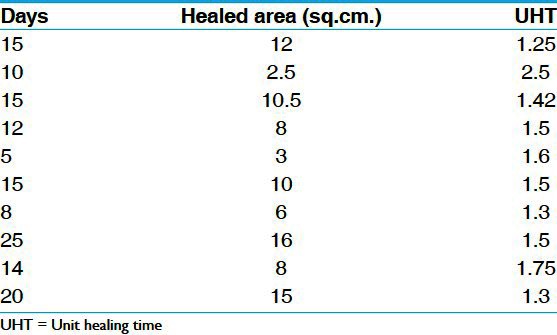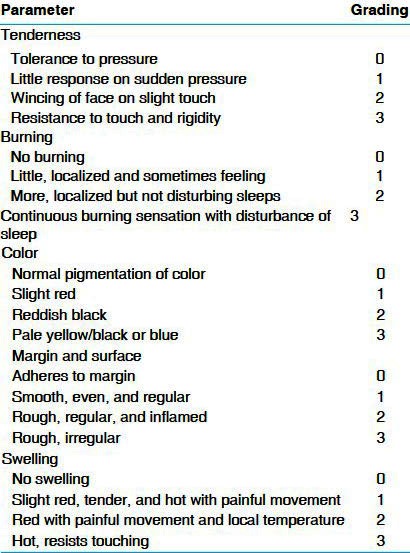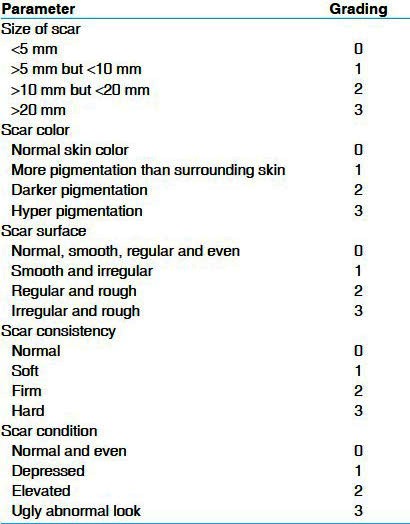Abstract
Vrana (wound) and its sequels play a major concern in the field of surgery as Vrana Ropana (wound healing) requires uneventful healing. The aim of the study was to evaluate the changes in physical and morphological properties due to topical application of Madhu (honey) on fresh traumatic wounds or cutaneous wounds. Ten patients of wounds of either sex were randomly selected. Site of the wound, shape, size, floor, and margin were recorded on day 0 and observed on day 7, 15, 20, and till the end of the healing for the progression of granulation, scar type, shape, size, and clinical symptoms. There was significant improvement in the healing process as Madhu possesses antibacterial, wound cleansing, wound healing properties and showed beneficiary effects.
Keywords: Madhu, Vrana, Vrana Ropana, Vrana shodhana
Introduction
Worldwide prevalence of wounds is believed to be 1% of world population,[1] whereas an Indian perspective of hospital based study shows leprosy (40%), diabetes (23%), venous disease (11%), and trauma (13%) were among important causes of lower extremity wounds. In that study, 13% of wounds were not directly linked to any known cause.[1] Acharya Sushruta defined Vrana (wound) as a complex phenomenon causing destruction or rupture or discontinuation of tissue in a particular part of the body with discoloration.[2,3] Acharya Sushruta elaborated the causative factors as Nija (intrinsic), Agantuja (external or traumatic) and advised 60 procedures in the management of different stages and types of wounds. He cautioned for the initial evaluation of the patient and the wound which includes the state of wound bed, phase of the wound healing, and the amount of wound exudates. After surgical procedures, honey is one of the ingredient applied on the wound or suture line, before covering with thick layered gauge and bandaging, prescribed by Acharya Sushruta.[2,3] Yogaratnakara also quoted the external application of Madhu on Sadyovrana (fresh traumatic wounds).[4]
Honey as it is hygroscopic in nature with a pH of 3.2-4.5,[5–7] prevents colonization and bacterial growth in tissues due to its acidic nature. Most microorganisms do not grow in pure honey because of its low water activity (aw) of 0.6.[8,9] Honey has antibacterial property.[10–14] The presence of hydrogen peroxide[15,16] and a high osmotic pressure[17] also contribute to the antibacterial effect of honey. In recent researches, honey was attributed with antibacterial effect against 60 species of aerobes and anaerobes, Gram positives and Gram negatives.[18] Worldwide, various brands of honey with standardized antibacterial activity processed as a medical product and sterilized by gamma irradiation is available commercially, e.g. Manuka Honey (New Zealand), Tualang Honey (Malaysia) without showing any adverse effects and toxicity.
Various clinical studies on honey and honey plus ghee were evaluated previously, for their wound healing property in the cases of infected wounds. The application of honey and ghee has shown disappearance of discharge within 2 to 3 days and the ulcers healed within 15 to 17 days.[19] In another clinical study, a case of infected wound on the anterior aspect of the leg was reported with a significant healing action of honey and Neem bark decoction on local application.[20]
Aim and Objective
Keeping the properties of honey in mind, a randomized clinical study has been conducted to evaluate wound healing property of non-processed honey on traumatic cutaneous wounds.
Materials and Methods
A total number of 10 patients of either sex, fulfilling the diagnostic criteria for cutaneous wounds, were randomly selected for the clinical trial.
Cases were selected from O.P.D. of Ayurvedic Specialty Clinic, District Head quarters Hospital, Rajahmundry, Andhra Pradesh, after taking permission from the Ethics committee and consent from the patient for the clinical trial.
Inclusion criteria
Patients having cutaneous wounds with classical signs and symptoms.
Patients without any severe systemic disease in the age group of 10 to 70 years of both sexes were selected.
Exclusion criteria
Patients below 10 years and above 70 years.
Patients suffering from varicose ulcers, lepromatous ulcers, syphilitic ulcers, skin malignancies, and HIV were excluded.
Investigations
Routine hematological investigations: Hemoglobin %, TLC (Total Leukocyte Count), DLC (Differential Leukocyte Count), ESR (Erythrocyte Sedimentation Rate).
Biochemical investigations: FBS (Fasting Blood Sugar), PPBS (Post-Prandial Blood Sugar), lipid profile, blood urea, serum creatinine.
Urine-Routine and microscopic examination.
Viral screening:-HBs Ag, HIV.
Criteria for clinical assessment
Area of wound on day zero was noted and recorded by a tracing paper to identify the shape, size which is further exactly measured by a graph paper and assessed in sq. cm. Observations were done on day 7, 15, 20, or after complete healing of wound.
The scoring symptoms and wound healing parameters[21] for the statistical analysis are as under.
Site of the wound
-
Size of the wound
Size of the wound = length × breadth in cms.
Pain
Assessment of pain was done with the help of Numerical Rating Scale (NRS).[22] Patient was advised to choose a number for grading 0-10 to describe their current pain which was shown below.
Numerical rating scale
-
Assesment of wound
-
Assesment of scar
Unit healing time
Wound healing was assessed by UHT (Unit Healing Time) and scoring of signs and symptoms. The UHT means number of days required for healing of per sq. cm area of wound. UHT was calculated by formula:-
UHT = TDRH/IAW sq.cm.
Where, TDRH = Total number of Days Required for Healing and IAW = Initial Area of Wound in square centimeter
Collection of honey
Honey was collected from a bee keeper, K. China Babu, Papa Rao Honey Industry, Anandapuram, Vuyyuru, near Vijayawada, Andhra Pradesh. The surrounding area spans with vegetable plantations. The bee keeper procured honey by extracting a ripe bee hive. After settling, it was filtered through a mesh filter to remove pieces of wax and particles, etc., and preserved in a clean autoclaved jar.
Application of honey
Before application of honey on the wound on the first day, wound was cleaned with normal saline, honey applied locally by soaking it in sterile cotton gauge, and dressed daily in the morning and evening.
Statistical analysis
The information obtained on the basis of observation related to the parameters was subjected to statistical analysis in terms of Mean, SD (Standard Deviation), and SE (Standard Error). Student's t test[23] was applied for the statistical significance. The results were interpreted at P < 0.05, P < 0.01, and P < 0.001 significance levels. The obtained results were interpreted as P > 0.01-Insignificant, P < 0.05-Significant, and P < 0.01 and 0.001-highly significant.
Observations and Results
General observations
In all cases (100%), the causative factor for cutaneous wounds was trauma or injury, in 70% cases site of the wound was lower limb whereas in 30% the upper limb shows the significance. Majority of the patients (30%) were in the age group of 31 to 40 years, implies to outgoing working tendency, 50% belongs to low-socioeconomic group, 60% were rural inhabitants.
Observation of biochemical parameters: 2 (20%) patients were in anemic state showing 9 gmHb% levels, 2 (20%) patients has slightly elevated blood glucose levels and controlled on dietic restrictions.
In this study, majority of wounds were in irregular shape (70%) as the causative factor is trauma, and with sloping edges, pinkish red granulation tissue on the base. Maximum patients were having regular bowel habits and regular micturition, 10% has smoking habit. 50% patients were in Kapha-Pitta Dehaprakruti, interpreted as maximum number of patients belongs to middle age who were having better capability for wound healing indicated by Acharya Sushruta.[24]
Effect of therapy
In this study, 10 patients were evaluated for the wound healing effect of honey on cutaneous wounds. Honey showed highly significant results in all clinical symptoms of cutaneous wounds and promoted natural healing process.
Pain relief (80%) was observed after completion of 15th day as honey possesses anti-inflammatory action and soothing property, thus reducing pain and swelling and accelerating the healing. Healthy granulation has developed after completion of 7th day in 50% cases. Tenderness reduced on 15th day in 80% cases. Burning sensation and discoloration surrounding the skin are markedly reduced on 7th day.
Effect of therapy on scar formation
Scar color and surface is smooth, regular, and even with soft consistency in 80% cases after complete healing as honey stimulated the epithelial cell growth with skin level.
Unit healing time
The UHT of wounds are shown in the Table 1 and Average UHT calculated was 1.56. Paired ‘t’ test: At 9 degrees of freedom, 5% significant limit of ‘t’ is 2.26, the observed t value for wound healing is 4.9 times the standard error; hence, honey accelerated the wound healing efficiently. t = 4.9, P < 0.001, significant.
Table 1.
UHT observed in individual woud

Discussion
The effect of Madhu in promoting VranaRopana[25] is attributed to its Madhura, Kashaya Rasa and Pichhila, Sheeta, Laghu Guna. Madhura Rasa of honey exerts direct nutrient effect on regeneration of tissue because it contains a wide range of amino acids, vitamins, and trace elements in addition to large quantities of readily assimilable sugars. Kashaya Rasa cleanse the wound surface and removes foul smell from wounds by destroying the bacteria which produce ammonia. Sheeta Guna is correlated as anti-inflammatory action of honey which soothes and promotes healing by reducing pain and inflammation. Pichhila Guna acts as moist retentive as moist wound environment is less painful, requires fewer dressing changes, and produces better cosmetic results.
Honey when comes in contact with wound, the glucose oxidase enzyme introduced to the honey by the bee[26] slowly releases the anti-septic hydrogen peroxide (H2O2). This H2O2 released at sufficient levels is effective against bacteria but does not cause tissue damaging and fibroblast growth is stimulated by H2O2. It has insulin-like effect and promotes wound healing.[27,28] Acidic nature of honey releases oxygen as new growing cells need oxygen and stimulates the white blood cells. Osmotic effect[29] of the honey keeps the wound moist and clean, it prevents the dressing sticking to the wound, as it belongs to moist retentive dressing material which promotes formation of clean healthy granulation tissue, and accelerates epithelialization of wound without producing any adverse effects. Honey dressings are easy for application and removal.
Honey promotes rapid healing as it stimulates tissue regeneration, angiogenesis, and fibroblast growth. Epithelial cell growth is stimulated as these cells grow with the skin level so that no scab is formed and so no excessive scarring and hypertrophication. Anti-inflammatory action of honey soothes and promotes healing by reducing pain and swelling.
Conclusion
On the basis of clinical observations obtained, it can be concluded that the trial drug Madhu (Honey) possess antibacterial and wound healing properties without showing any adverse effects. Honey is a potential and very useful dressing material and it renders economical advantage as it is cost saving when compared with conventional dressing materials. Honey is an ideal firstaid dressing material, especially for patients in remote areas. In the present study, wound healing activity of honey on cutaneous wounds showed highly significant results, but further studies on large samples are required for an authentic conclusion.
References
- 1.Gupta SK, Shukla VK. In Management of Wound Healing. 1st ed. New Delhi: Jaypee Brothers Medical Publishers (P) Ltd; 2007. Epidemiological Study of Wounds: An Indian Perspective; p. 1. [Google Scholar]
- 2.Sushruta . In: Sushruta Samhita, Chikitsasthana, Dwivraneeyachikitsitam, 1/6. Reprint. Jadavaji Trikamji Acharya., editor. Varanasi: Choukhambha Surabharati Prakasan; 1994. p. 311. [Google Scholar]
- 3.Ibidem. Sushruta Samhita, Sutra Sthana, Agropaharaneeyadhyaya 5/7. :19. [Google Scholar]
- 4.Yogaratnakara . In: Uttarardha, Sadyovrana Nidana, Vaidya Lakshmipati Shastri commentator. 6thed. Brahma Shankara Shastri., editor. Varanasi: Chaukhambha Sanskrit Bhawan; 1997. p. 182. [Google Scholar]
- 5.White JW, Riethof M, Subers M, Kushinir I. USDA Tech. Bull. 1261. Washington, DC: Agriculture Research Service; 1962. Composition of American Honeys. [Google Scholar]
- 6. [Last accesed on 2010 Sep 29]. Available from: http://bio.waikato.ac.nz/honey/honey_intro.shtml#Acidity .
- 7.Honey [Last accesed on 2010 Aug 3]. Available from: http://en.wikipedia.org/wiki/Talk:Honey#The_antibacterial_activity .
- 8.Prescott L, Harley JP, Klein DA. Microbiology. Boston: WCB/McGrawHill; 1999. [Google Scholar]
- 9.Honey Wikipedia. [Last accessed on 2010 Nov 2]. Available from: http//en.wikipedia.org/wiki/Honey .
- 10.Molan PC. The Antibacterial activity of Honey. 1. The nature of the antibacterial activity. Bee world. 1992;73:5–28. [Google Scholar]
- 11.Molan PC. The Antibacterial activity of Honey. 2. Variation in the potency of the antibacterial activity. Bee World. 1992;73:59–76. [Google Scholar]
- 12.Cooper R. Honey in wound care: Antibacterial properties. GMS Krankenhhyg Interdiszip. 2007;2:Doc51. [PMC free article] [PubMed] [Google Scholar]
- 13.Bulman MW. Honey as a surgical Dressing. Middlesex Hosp J. 1955:55188–9. [Google Scholar]
- 14.Hutton DJ. Treatment of pressure sores. Nurs Times. 1966;62:1533–4. [PubMed] [Google Scholar]
- 15.Kumar A, Sharma VK, Singh HP, Prakash P, Singh SP. Efficacy of some indigenous drugs in tissues repair in buffalos. Indian Vet J. 1993;70:42–4. [Google Scholar]
- 16.Oryan A, Zaker SR. Effects of topical application of honey on cutaneous wound healing in rabbits. Zentralbl Veterinarmed A. 1998;45:181–8. doi: 10.1111/j.1439-0442.1998.tb00815.x. [DOI] [PubMed] [Google Scholar]
- 17.Bose B. Honey or sugar in treatment of infected wounds? Lancet. 1982;1:963. doi: 10.1016/s0140-6736(82)91959-6. [DOI] [PubMed] [Google Scholar]
- 18.Al-Waili NS. Investigating the anti microbial activity of natural Honey and its effects on the pathogenic bacterial infections of Surgical wounds and Conjunctiva. J Med Food. 2004;7:210–22. doi: 10.1089/1096620041224139. [DOI] [PubMed] [Google Scholar]
- 19.Amrut Kumarchand K. Jamnagar: IPGT and R, GAU; 1981. A comprehensive study of 60 measures of Vrana and the roll of Madhu-Sarpi in Vranropan, (Thesis), Dept of Shalya-Shalakya. [Google Scholar]
- 20.Dudhamal TS, Gupta SK, Bhuyan C. Role of honey (Madhu) in management of wounds (Dushta Vrana) Int J Ayurveda Res. 2010;1:271–3. doi: 10.4103/0974-7788.76793. [DOI] [PMC free article] [PubMed] [Google Scholar]
- 21.Mehra R. 1st ed. Varanasi: Chaukhambha Publishers; 2005. Vrana and its healing; pp. 276–83. [Google Scholar]
- 22.Solowiej K, Mason V. Psychological stress and pain in wound care, Part-2: A review of pain and stress assessment tools. J Wound Care. 2010;19:110–5. doi: 10.12968/jowc.2010.19.3.47280. [DOI] [PubMed] [Google Scholar]
- 23.Mahajan BK. 6th ed. New Delhi: Jaypee Brothers medical publishers (P) Ltd; 1997. Methods in Biostatics; pp. 141–51. 329. [Google Scholar]
- 24.Sushruta . In: Sushruta Samhita, Sutra sthana, 23/3. Reprint. Jadavaji Trikamji Acharya., editor. Varanasi: Choukhambha Surabharati Prakasan; 1994. [Google Scholar]
- 25.Ibidem. Sushruta Samhita, Sutra Sthana, Dravadravyavidhimadhyayam 45/132. :161. [Google Scholar]
- 26.Marshal C. The use of honey in wound care: A review article. Br J Podiatry. 2002;5:47–9. [Google Scholar]
- 27.Marshal C, Janet Q, Manjooran J. Honey Vs Iodine following toe nail surgery. Wounds U K. 2005;1:10–8. [Google Scholar]
- 28.Mc Intosh CD, Thomson CE. Honey dressings versusparaffin tulle Grass following toe nail surgery. J Wound Care. 2006;15:133–6. doi: 10.12968/jowc.2006.15.3.26877. [DOI] [PubMed] [Google Scholar]
- 29.Medhi B, Puri A, Upadhayay S, Kaman L. Topical application of Honey in the treatment of wound healing: A meta analysis. J K Science. 2008;10:166–9. [Google Scholar]




